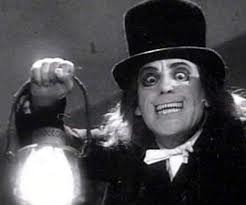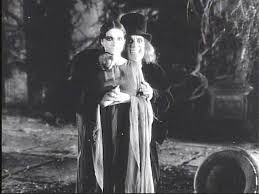THE CLASSIC HORROR FILM
By Jeffrey-Baptiste Tarlofsky
By Jeffrey-Baptiste Tarlofsky
Lesson 4 consists of six sections.
In each section, (1) first watch the video lecture, (2) next read the transcript of the lecture (3), then watch the film excerpt. Repeat for each section. For example, in section 2, watch video lecture part 2, next read the transcript for video lecture part 2, then watch film excerpt #2.
レッスン4は6つのセクションから構成されています。各セッションでは、以下の順番で授業を受けてください。
(1) ビデオレクチャー(動画)を見てください。(2) レクチャーのテキストを読んでください。(3) 動画(Freaks excerpt #1(セクション1の場合))を見てください。各セクションで上記のステップ(1)から(3)を繰り返してください。
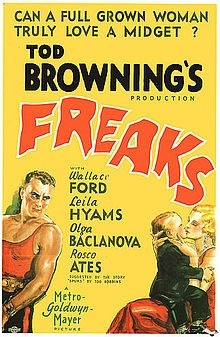
Directed by Tod Browning
Produced by Tod Browning, Harry Rapf, Irving Thalbert
Starring: Harry Earles and Olga Baclanova
Distributed by Metro-Goldwyn-Mayer
Running time: 90 minutes (Original cut) 64 minutes (Edited cut)
Budget: $316,000-$350,000 (the exact figures is not known)
Earnings: The film lost $164,000 on original release
Tod Browning and Lon Chaney, the gruesome twosome, really were a natural team. They were close to one another both personally and professionally, working together on a total of ten films over ten years. One reason their collaboration worked so well was that Tod Browning was the only person who seemed capable of “directing” Chaney. Everyone who worked with him agreed that Lon Chaney was both a genius and a gentleman. As a gentleman he was always polite to his directors, as a genius he usually ignored them and did exactly what he wanted to do. Hollywood has had hundreds if not thousands of egotistical and difficult to work with movie stars, but only one Lon Chaney. Directors simply withered in front of him because they knew he was a genius. Tod Browning did not wither in front of Lon Chaney. He could talk to him as an equal and as a friend because that is what the men were to each other. What was the basis of this friendship and mutual respect?
Recall that Lon Chaney grew up with two deaf and dumb parents. It is one reason why he was such a fine silent film actor. Mime; the language of facial expression, gesture and body language was actually his first language and that was the language of silent film. But there was something else about Chaney’s childhood which was absolutely formative. Because both his parents had disabilities, Chaney grew up with a natural sympathy for and understanding of all people with disabilities and the struggles they faced. Is it any wonder that so many of his characters faced similar challenges?
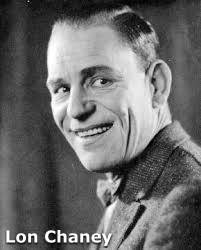
Recall that Lon Chaney grew up with two deaf and dumb parents. It is one reason why he was such a fine silent film actor. Mime; the language of facial expression, gesture and body language was actually his first language and that was the language of silent film. But there was something else about Chaney’s childhood which was absolutely formative. Because both his parents had disabilities, Chaney grew up with a natural sympathy for and understanding of all people with disabilities and the struggles they faced. Is it any wonder that so many of his characters faced similar challenges?
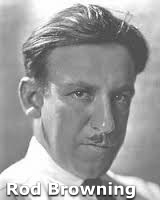
Now, in contrast to Chaney whose family was not at all well off, Tod Browning came from a wealthy family. But, Browning’s family was unhappy and he ran away from his comfortable, but unhappy home at the age of age sixteen to join the circus. He spent years working in circuses and carnivals at first as a “barker” (someone who calls out what the acts inside the circus tents are) and then as a performer. Browning could juggle, dance and even perform magic tricks. The people who work in circuses, fairs and carnivals travel a great deal and are usually outsiders in the places they visit, so they spend most of their time with each other and form a kind of family unit. Tod Browning felt comfortable and safe with his adopted circus family and among those he became closest to were the people known as the “freaks”; the dwarves, giants, bearded ladies, pinheads, Siamese twins and people with other unusual physical traits who populate the circus “sideshows”. Such people as these might have been killed at birth or locked away by their families hundreds of years ago or given away to the church as Quasimodo was, or an institution as Erich was. Quasimodo and Erich were also “freaks” which is really just another word for “monster”. Freak shows were widespread throughout the world even well into the 20th century and in some parts of the world they still exist even today. We can now understand what the bond between Tod Browning and Lon Chaney was. Both men had a deep sympathetic regard for those people in society with certain kinds of handicaps such as deafness or physical deformity.
We are now going to take a look at one of the strangest “horror” films ever made, Tod Browning’s notorious Freaks (1932). The film was very controversial at the time it was released because Tod Browning’s actors playing the part of circus freaks were, in fact, real circus freaks. Movie audiences were willing to watch Lon Chaney’s “monsters” because they knew that under the make-up Chaney was a normal man. But Browning’s actors used no make-up or other tricks. They were real people. For some members of the audience it was simply too much. They were frightened, shocked, disgusted, in other words, horrified. But it was not the kind of horror they wanted to feel. It was not a “safe” kind of horror. On the other hand, other people accused Browning of exploitation. They believed he was just using the freaks to make money with his movie. In fact, what Browning was really doing was something altogether different. He was neither trying to horrify audiences nor exploit the freaks. He was actually trying to show the film audiences of 1932 that the freaks were really just like everyone else except that they were often isolated, mistreated and discriminated against due to their handicaps. The film was actually made with a great deal of compassion and sympathy, the same sort of sympathy Lon Chaney brought to his characters.
Now let us watch Excerpt #1 from Freaks, the opening credits of the film.
This introduction was added after the film’s original release because the reaction to the film was so negative. Browning felt he had to add this lengthy explanation so people would understand what he was really trying to do. It didn’t help at all. Any time a film has to explain itself there is obviously a problem. One of the rules of film making is: don’t tell us, show us.
Now we will meet the characters around who the story is centered.
The trapeze artist, Cleopatra was played by Olga Baclanova, a Russian born actress we will see again in another film later this semester. She was famous for playing sexy villains. Hans and Freida were actually played by brother and sister, Harry and Daisy Earles, German immigrants. Despite the unusual characters, we have quite a conventional story, a typical love triangle consisting of two women competing for one man. It is also typical in these stories for one of the women to be good and the other to be evil. This is really the whole story in a nutshell. However, Tod Browning spends about half of the film just showing us how the people known as “freaks” go about their ordinary lives. It isn’t easy to try to get along in a world where people find them shocking, revolting and even horrifying as we shall see in the next excerpt.
This scene is obviously an appeal to our human compassion and understanding. Who does not want to play outside in the sunshine, after all? But the scene has also been criticized (and I think justly so) for infantilizing the freaks. To “infantilize” (from the word “infant”) is to treat someone who is not a child as if they were. These people are all adults, but the woman who cares for them calls them “children” and the land owner agrees with her. Was this the only way for people to feel compassion for the freaks? Wasn’t it possible for even Tod Browning to simply treat them as …well, equals? It is an interesting question. Let me tell you a story. When I first came to Japan I was often in need of help to find my way around. If Japanese people saw that I was lost they would often stop to help me find my way. This was very much appreciated. But, one day I found a sign advising people how to behave during an emergency. Along with an arrow pointing in the direction of what I assumed was a gathering place in case of emergencies, there was also some writing obviously explaining what to do. I could not read the Japanese so I asked my friend to translate it for me. He laughed a little bit. “Well, what does it say?” I asked. He said “It says ‘Please don’t forget to help lost children, pets and foreigners!’”
There is no question that this was written out of genuine concern for the well-being of lost children, pets and foreigners. Before going on to the next excerpt why don’t you think about this for a moment or two.
Any thoughts? You can write them down in your notes.
Now we know that Cleopatra and Hercules are not just making fun of Hans and taking advantage of him, but that they are also planning to murder him for his money. This is what makes Freaks a full-fledged Horror movie. It is not enough to simply display the so called “monsters” in a horror movie, there must also be an element of danger, a looming threat in the story.
We now come to the most famous scene in the film; the wedding.
So the actual danger in the film is not from the so called “monsters”, but from the normal people. We should remind ourselves of that definition of the word “monster” we discussed earlier. A monster is either very ugly or evil, but does not have to be both. Eric, the phantom was both ugly and evil, Quasimodo, the hunchback was ugly but not evil. The freaks in Freaks are ugly in the conventional sense of that word, but they are not evil. On the other han , Cleopatra and Hercules are normal looking, but they are evil. Freaks asks us to consider who the real monsters in the film are.
Freaks was a disaster for MGM studios which produced it and the film almost ended the career of Tod Browning who only directed four more pictures over the next seven years before retiring at only fifty-nine. Yet, today the film is considered a cult classic and is appreciated for its attempt to show people with disabilities as human beings with the same loves and sorrows as the rest of us. What changed? Audiences did. People in 1932 reacted to Brownings film with genuine shock, disgust and horror because it showed audiences a reality they did not want to experience… or perhaps one they were not allowed to experience?
The year that Freaks was made is also the year Hollywood began enforcing something called the “production code” which was really a system of self-censorship. The production code was a list of rules about things that could not be shown in films made in and /or distributed in America. The list included using curse words like “damn” or “fuck”, it forbade nudity or semi nudity, it forbade films from showing prostitution, abortion, drug use, sexual relations between different races or any homosexual relations at all. Freaks would never have passed the production code if it had been made a year later and in fact, the film actually was banned in several parts of the country and eventually withdrawn altogether. The production code effectively shut down the freedom of directors like Tod Browning to challenge our ideas about what “monsters” really were. It would be well over thirty years before directors once again had that freedom. But the production code did much more than interfere with the freedom of writers and directors and actors to freely express their ideas, it also stopped audiences from being able to encounter those ideas. So, for more than thirty years American audiences could not see films which included nudity or show us social problems such as drug addiction or prostitution, Americans were not allowed to see Black people and White people dating or two men kissing. In other words…the production code infantilized the American audiences.
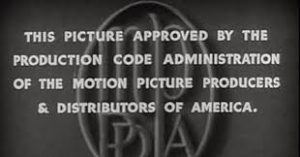
Motion picture production code
The Production code died more than fifty years ago and today American films deal with all those topics I said were forbidden by the production code back in 1932. Both films and society have matured. We aren’t children any more. Among the best changes that have occurred is in how we treat people who are different from us. In 2008 America elected a president with a Black father and a White mother. When Barack Obama was born he could not have seen a movie about his own parents. More recently the United States of America joined most of the rest of the developed world in recognizing same sex marriage.
Since I came to Japan more than thirty years ago I have seen tremendous progress in our society. When I first came to Japan it was still unusual for people with disabilities to be seen in public. They were still hidden away at home or in institutions because their families felt ashamed of them. Today, one of the things I am proudest to see changed in Japan is the attitudes towards differences. When I first taught in Japan I never had any students in wheelchairs or students with other special needs. Now…if not for the Corona Virus …. I would see such students every day on our campuses.
That is real progress.
Let me end today’s lecture with one last story. This happened about fifteen years ago when I was teaching this class. There was a boy who came to the first lecture who had a condition which made his face very unusual. A long time ago he might have been called a “monster” or a “freak”. I thought “how can I teach this class with this boy here? Won’t he feel uncomfortable when I talk about these things?” Please understand, I did not in any way fear him, but I was afraid for him. I did not want to hurt him. Then I thought, “He has a right to be treated in exactly the same way as any other student in this class. If I change anything at all, I would be discriminating against him. He is just one more student in the class, treat him that way”. So I gave my lecture, the same lecture you have just watched. At the end of the lecture he came up to talk to me…and I admit that I was very nervous about what he would say. He didn’t say very much at all. He just said “thank you for your lecture today” and that was all.
People don’t want to be treated as special or different even if that means being “nice” to them. People just want to be treated like everyone else. I think we owe them that. I think that was Tod Brownings message in Freaks.
Browning’s controversial film almost ended his career as audiences rejected the film as grotesque and exploitive. This was a personal as well as professional blow to Browning as he had sought to make a film that depicted the circus “freaks” as human beings with the same loves and sorrows as everyone else, not “monsters”.
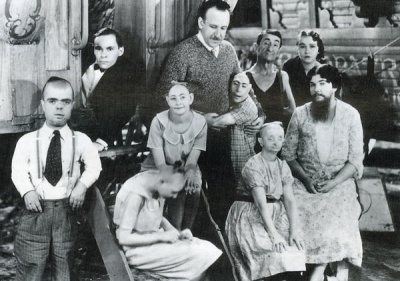
Tod Browning with some members of the cast of the film Freaks (1932)
